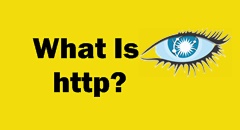What Is Https Full Form | Https Explained In Details?
In this article, we explain what HTTPS is, what it is, and how it is classified, and we will learn from it all the factors that play a role in creating HTTPS and its use in web applications.
Before we delve deeper into the understanding of HTTP and HTTPS protocol, let us try to understand the meaning of the word “protocol.” HTTPS stands for “Secure HTTPS hypertext transfer protocol” and is the encrypted version of HTTP.
Like HTTP, HTTPS is used to request web data, but strictly speaking, it is not a separate protocol and refers to encrypted SSL / TLS connections.
Let’s Understand The Use Of https
However, HTTPS signals the browser to use an additional encryption layer (SSL / TLS) to protect the data traffic. In addition, the information of the user is encrypted by the SSL protocol of their web browser before it is sent over the Internet. HTTPS fully converts HTTP to TLS and encrypts the entire underlying HTTP protocol.
When you connect to an HTTPS-secured server, your web browser checks that the website’s security certificate has been issued by a legitimate certification authority and checks it against a database of secure websites such as banks that automatically redirect you to HTTPS.
When you visit a website that is encrypted with SSL, your browser connects to and binds to the webserver. Your browser will look for an SSL certificate, and if it is signed by a publicly trusted certification authority (CA), trust the certificate.
If it is trusted and belongs to your domain, it will be marked with a green lock and displayed in your web browser, reducing the risk of being confused with a spam website. SSL and TLS certificates are both signed by publicly trusted certification bodies for their safety.
If the website has a padlock with https, the certificate has expired, meaning that the connection would not be secure. Websites that prefer HTTPS wait for a connection over HTTP until the user is redirected to an HTTPS url. Websites running on HTTPS can be redirected if you enter http and deliver over a secure connection, even if it is not secure at all.
This is the full form of https and it is important, so read this article to learn more about it and its meaning. HTTPS should protect your website even if it does not handle sensitive communications.
You can maintain your data privacy through a number of protocols, including SSL / TLS, TLS2, SSL 3.0, and TLS4. Your privacy and data can be protected in a secure manner by using the latest versions of these protocols, including TLS1.1, HTTPS2, and HTTPS3.
You can also maintain your private data in a secure manner by using the latest versions of this protocol, including HTTPS 1.3, encryption, security, and SSL 4.2.5.
The HTTP / HTTPS protocol serves the majority of the population, although there are many other protocols, such as HTTP2, HTTP3, HTTPS4, and HTTP5.
Users trust that the protocol’s encryption layer, SSL / TLS, is adequately protected against eavesdropping. SSL and TLS are particularly suitable for HTTP because they authenticate only one side of the communication.
For this reason, SSL certificates are the most important part of the setup: only the possession of domain names confirms the issued certificate. An SSL certificate ensures that the owner of a web server can say what the certificate says, and not vice versa.
When you type “https” in the address bar in front of a domain, the browser is prompted to connect via HTTPS. If you type “http: / /” at the end of the URL bar instead of just before the domain name, your browser’s URL bar will tell you to connect to the webserver.
HTTPS also uses TCP (Transmission Control Protocol) to send and receive data packets, but it does so via Transport Layer Security (TLS), which encrypts the connection.
HTTPS should not be confused with HTTP, which is rarely used and specified in RFC 2660. For maximum compatibility, port 443 is the standard (and therefore recommended) for secure SSL / TLS communication.
HTTPS consists of an encrypted connection between server and client and an encryption protocol TLS (Transport Layer Security). This communication protocol encrypts the connection with the TLS protocol (TLS 1.2, TLS 2.0, or TLS 3.1).
This communication protocol is encrypted with Transport Layer Security (TLS) and TLS encryption (SSL / TLS).
HTTPS is required to have an SSL certificate, and SSL certificates are required for HTTP and HTTPS. These certificates allow multiple domains to be secured with an SSL certificate and are signed by a CA.
DigiCert issues sell and issues SSL certificates, as well as certificates for other companies such as Google, Facebook, Microsoft, Yahoo, Twitter, etc.
What Is SSL Certificate?
An SSL certificate is a small data file that cryptographically establishes an encrypted connection between a web server and the browser. If the address in the address bar of your web browser starts with https://, you will be able to see that you are connected to a web page with an HTTPS connection. As you can see, your browser will hide “https://” in the bottom right corner of the page.
At the end of this article, you will find a list of all websites that are secured by SSL certificates, as well as a link to each website.














